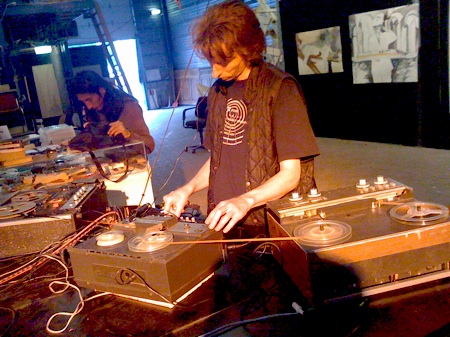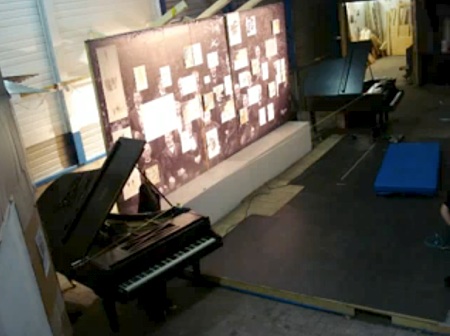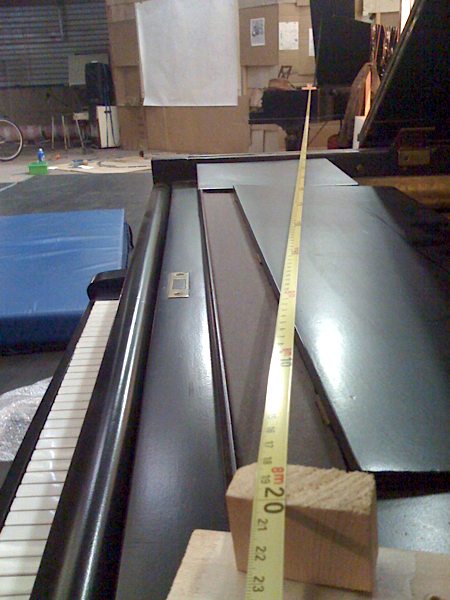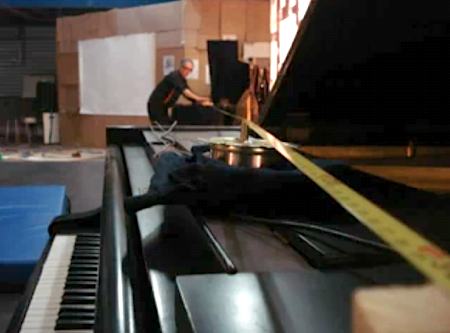 Please take a moment to sign
the online petition, and support ARM (the Artspace Rondeel in Maastricht,
the Netherlands). Because the rent demanded by the owner of the Rondeel
as of 2010 is exorbitant and far exceeds the funds available to ARM, chances
are that ARM will be forced to re-house elsewhere, possibly even elsewhere
in Europe. The online petition is one among actions underway to convince
cultural decision- and policy makers in Maastricht that letting ARM go,
is not in the interest of a city that has the ambition to become a European
Cultural Capital in the near future ... Thanks for signing! ... Read on for more
about the Artspace...
Please take a moment to sign
the online petition, and support ARM (the Artspace Rondeel in Maastricht,
the Netherlands). Because the rent demanded by the owner of the Rondeel
as of 2010 is exorbitant and far exceeds the funds available to ARM, chances
are that ARM will be forced to re-house elsewhere, possibly even elsewhere
in Europe. The online petition is one among actions underway to convince
cultural decision- and policy makers in Maastricht that letting ARM go,
is not in the interest of a city that has the ambition to become a European
Cultural Capital in the near future ... Thanks for signing! ... Read on for more
about the Artspace...
Playing The Popular Classics [KT2009, iv]
june 01, 2009.
7 min read 🤓
In a recent article in Geometer Magazine (january 2009) James Wyness described sound art as an "emerging field of loosely related practices lacking a core practice". If not for the attribute 'emerging' it would be an apt summary of the first paragraph of an earlier episode of this series of reports on the 10th edition of the Kunsttour, 21st-24th in Maastricht, the Netherlands, which on the occasion of its jubilee put a spotlight on the arts of sound.
If anything, it is the use of sound art as a label that may be considered (still) 'emerging'. The 'loosely related practices' that it is being applied to have themselves a long and fascinating history, which is part of and closely parallels that of the rise of modernism in the late 19th and early 20th century. I think of sound art as being born at that time, when music quite jubilantly burst out of the bubble that confined it to being an art of pitches, a demarcation that is nicely reflected in its - obsolescent - synonyms Tonkunst (in German) and toonkunst (in Dutch). In subsequent developments, as we all know, technology came to play a major role, and over much of the 20th century the evolving techniques for audio recording, duplication and manipulation profoundly changed both the production and the consumption of music, in the broadest possible sense.
Though the field of 'loosely related practices' that nowadays is labeled 'sound art' may seem to lack a core practice, there are a number of core techniques that have been applied throughout much of its history. Often their practical implementation and application changed with the evolution of technology, but not the principle. These core techniques one finds of course also at the heart of those works that are an undeniable part of the canon of sound art, whatever which way one wants to define it.
Signal feedback is one of these core techniques, which can be
applied in a great many different ways. By connecting a microphone to an
amplifier, turning up the volume and - if necessary - pointing the microphone
in the direction of the loudspeakers. Or in some way feeding the playback of a recording
back into the recording, which is the principle of the technique that became
widely known as frippertronics
and that originally was done with reel-to-reel tape machines (
* ). A fine example and a classic of sound art not only for historical reasons, is Terry Riley's
Music
for Ken Dewey's play The Gift,
from 1963, which however seems to be but little known.
In the picture below you see Séamus
O'Donnell, who is installing and testing the three-part reel-to-reel
frippertronics set-up that he used in his performance at the ArtSpace
Rondeel, during the sound event that took place there on friday may 22nd
as part of the Kunsttour. Classic, indeed.
[ Click to listen ![]() to a short
unedited lifeloop
test run that I recorded on my iPhone while I stood watching Séamus at work. ]
to a short
unedited lifeloop
test run that I recorded on my iPhone while I stood watching Séamus at work. ]

Signal feedback, but of a very different kind, also plays a crucial role in Rébus' reconstruction of Music on A Long Thin Wire, another undisputed milestone in the history of sound art, due to American composer Alvin Lucier (1977). Lucier's installation in its sheer simplicity has a very strong visual and auditory impact, not in the least through the singular riches and variation of the undulating sound field that it produces. Lucier's wire 'plays itself': it forms a complex and unpredictable dynamical system that will react to and vary with even very slight changes in its surroundings.
In Rébus' version the wire is a long thin metallic measuring ribbon, and instead of using a magnet to make the wire vibrate, he uses a vibrating element that passes its oscillations on to the wire through physical contact, via a short metal cylinder.
Lucier's instructions for the installation say to attach each of the ends of the wire to a table. But in the ArtSpace on saturday may 23rd, instead we used the two grand piano's that are standing around there. It took some heavy lifting and manoeuvring to get them into place, but it was worth the effort. In the pictures you see how it looked: like a very long narrow bridge crossing a ravine, now doesn't it? From the second photo you may gather that our wire measured 8 meters and 20 centimeters. In the third you see the vibrator that moves the wire, also used to feed it back its own signal.
 |
 |
 |
It all functioned and sounded just fine, that saturday in the ArtSpace Rondeel. In a chain of performances that included contributions by Klaas Hübner, Maja Gehrig, Kaspar König, Simon Berz and Michelle Ettlin, we used the installation as our instrument: Rébus sat at one of the piano's, while I sat down at the other one. We then played with and modified the sound of the wire by varying its tension by holding, tearing or slightly pushing each of the instruments. Indeed, as Maja observed, all that time of play each of us was tightly and silently embracing a big black piano ...
Performing this variation on Lucier's 'Music on a long thin wire' was a very special experience, and part of a quiet and remarkably thoughtful evening/night at the ArtSpace Rondeel, which, thanks to the hospitality, energy and enthusiasm of Kaspar, Maja and other ArtSpace tenants, provided a fabulous playground for sonic and other adventurers, pretty much non-stop during this year's Kunsttour.
Some of the atmosphere of the evening, of the setting up and tuning of the long thin wire-installation, and of the morning-after ambiance at the Art Space, are captured by Rébus' in his third Kunsttour uTube, which, very rightly so, ends with an auto-portrait of its author ...
[ See and hear more details of the same (but a couple of meters longer) 'thin wire' in
"Ivo
on a long thin wire", where young Ivo Rébus is assisting in a try-out of the installation outside in the garden ...
Earlier last month, on may 2nd, Rébus organised an evening in hommage to
Alvin Lucier in the Saint-Merry church in Paris. There his adaptation of
the Music on a Long Thin Wire functioned as an installation, which is more
faithful to Lucier's own intentions than the way in which we played it in
Maastricht. Here is
a short uTube impression. The evening also featured Dominique Peysson
as the performer in Music for Solo Performer from 1965. Dominique's
amplified brainwaves trigger a collection of small percussion instruments
set up around her. Also
hereof a short uTube ... ]
next: More Best Before [KT2009, v]
[ previous KT2009-entry : "Also high bridges over the river" ]
SoundBlog entries about the yearly Kunsttour in Maastricht, the Netherlands:
(june 06, 2013) - A Carcassonne Yodel in Blue [Kunsttour 2013]
(july 03, 2011) - Life is a Color Wire 3 - table version [KT2011]
(june 17, 2010) - Sunny soundy days [KT2010, iii]
(june 10, 2010) - A kitchen table and a game of cards [KT2010, ii]
(may 30, 2010) - Auto*noom en un*titled [KT2010, i]
(june 13, 2009) - More Best Before [KT2009, v]
(june 01, 2009) - Playing The Popular Classics [KT2009, iv]
(may 30, 2009) - "Also high bridges over the river" [KT2009, iii]
(may 28, 2009) - A sound is a sound that sounds [KT2009, ii]
(may 23, 2009) - It feels like summer in the city [KT2009, i]
(june 06, 2008) - Raudio Graffiti: almost live ! [KT2008]
(september 04, 2007) - "leve ookoi!" - iii. ... under scare vogel crow vlucht score down ... [KT2007, iii]
(august 22, 2007) - "leve ookoi!" - ii. OK. Let's Dance... [KT2007, ii]
(august 12, 2007) - "leve ookoi!" - i. Certified Reconditioned [KT2007, i]
(june 04, 2006) - Sonofakunsttoer [KT2006]
notes __ ::
(*) A modern tape-less implementation of frippertronics
consists in the setting up of a live audio-webstream, and feeding the play-back
of the stream signal back into the stream. The (varying) lag (the
time lapse between send and receive of the signal) then
corresponds to the (variable) distance between the tape machines in the
'classic' reel-to-reel set-up. With the
ookoi we have been practicing 'stream frippertronics' ever
since our earliest
2004 'streaming performances', from the island of Ameland, which provided
a nice conceptual link to our 1980
Signs & Symptoms. [ ^ ]
tags: Maastricht, Kunsttour, sound art
# .312.
Read more about Artspace Rondeel Maastricht (ARM) on the SoundBlog:
(june 28, 2011) - the end of an arm, the end of an era
(may 30, 2010) - Auto*noom
en un*titled
(february 24, 2010) - "Zonder
Vreesch, want immer Dapper, gaan wij des Zondags naar den Kapper..."
(november 11, 2009) - Waiting
in the Wings, often
(july 09, 2009)- Cover
thyself
(june 01, 2009) - Playing
The Popular Classics
(april 01, 2009) - A
Block with a Name
(june 06, 2008) - Raudio
Graffiti: almost live !
comments for Playing the Popular Classics [KT2009, iv] ::
|
Comments are disabled |